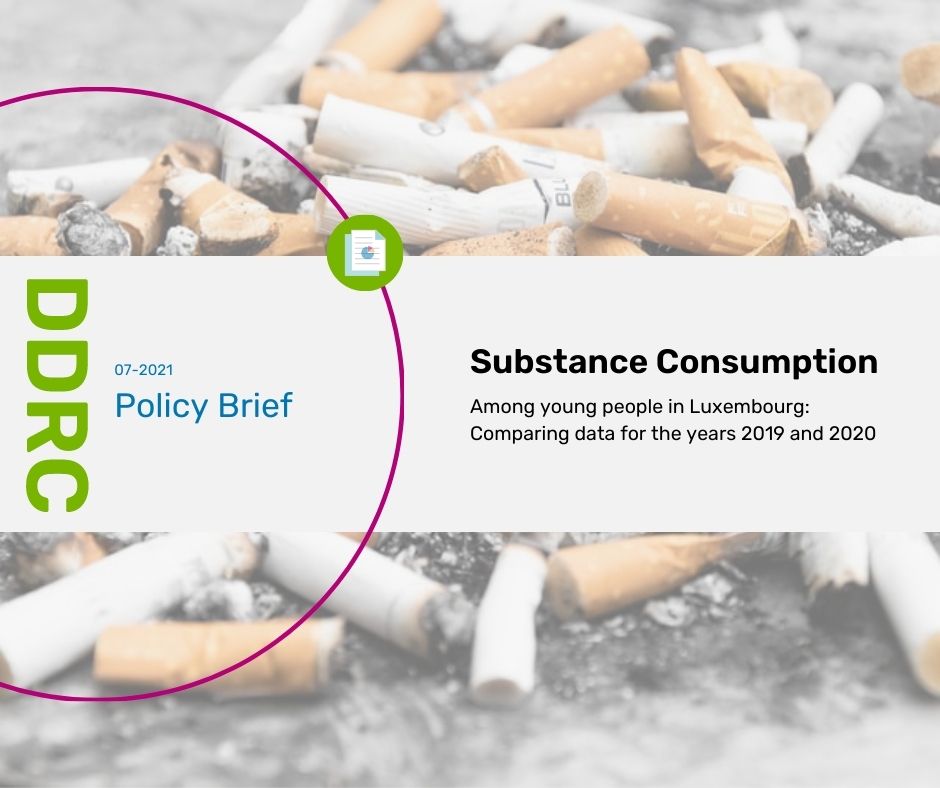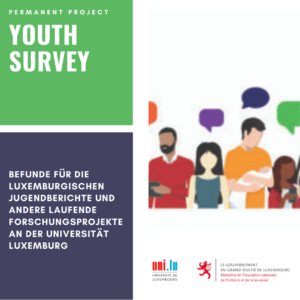Alcohol, tobacco, cannabis: how widespread is the use of psychoactive substances among young people in the Grand Duchy? To map the substance use of adolescents and young adults in Luxembourg, the representative population surveys Youth Survey Luxembourg (2019) and YAC (Young People and COVID-19, 2020) asked questions about the use of alcohol, nicotine and cannabis. Among other questions, 12- to 29-year-olds were asked whether they had used these substances at least once in the past 30 days. This website entry presents survey data from 2019 and 2020 regarding substance consumption among young people in Luxembourg in an interactive data tool.
Jump to content
Results on substance use among adolescents in Luxembourg
At just under 68%, more than half of respondents reported having used alcohol in the past 30 days in 2020. Just under one-fifth of respondents reported having used tobacco and just under one-tenth reported having used cannabis.
In the adult population (Luxembourg Institute of Health, 2017) and in most countries around the world (WHO, 2018), alcohol use is significantly more prevalent among men than women. However, for adolescents and young adults in Luxembourg, there was little difference in alcohol use between genders. For tobacco and cannabis use, however, they very much existed: twice as many male as female young adults reported using cannabis. Tobacco use was also somewhat more widespread among men than among women in 2020. An international comparison showed similar trends between the sexes for cannabis use.
For alcohol, tobacco and cannabis, different patterns of use by age were evident in each case. The proportion of those who used alcohol is higher in each higher age category. The proportion of tobacco users is lower in the 16- to 19-year-old (or 12- to 15-year-old) age category than in the 20- to 24-year-old (or 25- to 29-year-old) age category. Cannabis use is lowest in the youngest and oldest age categories and highest in the middle age category.
Alcohol use is lowest among male and female college students. Respondents who were unemployed at the time of the survey were slightly more likely to report drinking alcohol than students. Alcohol consumption was most prevalent among employed persons.
Photo by Pavel Pjatakov via Unsplash.com
Discover the data: substance use in the data tool
Klicken Sie auf den unteren Button, um den Inhalt von hdbt.shinyapps.io zu laden.
Data-Tool
Survey data in comparison: reading the data tool correctly
The data tool maps the substance use of respondents in 2019 and 2020. The figures for 2019 come from the Youth Survey Luxembourg 2019, in which 2593 young people aged 16 to 29 were surveyed. In survey research, researchers then write it down like this: n=2593, read: “The number of respondents was 2539 people.”
For 2020, the figures are based on the YAC survey. For this, a total of 4189 young people between the ages of 12 and 29 were surveyed. This is a wider age range than in the 2019 survey. Why is it important to point this out?
Especially when using the data tool to compare substance use between 2019 and 2020, it is important to keep in mind that only data from 16- to 19-year-olds can be included from the 2020 YAC survey. The “n” is therefore smaller when comparing. This is because values for 12- to 16-year-olds have no point of comparison in the 2019 data.
Conclusion: no statistically significant differences in substance use between 2019 and 2020
In the substance groups alcohol, tobacco and cannabis, a minimal upward trend in consumption can be observed for 2019 and 2020. The consumption of alcohol, tobacco and cannabis is marginally higher in 2020 by 0.4 to 1.4 percentage points. When the stochastic margin of error is included, no statistically significant differences can be observed. Thus, no evidence of differences in substance use can be found for 2019 and 2020.
An international comparison shows that the proportion of children, adolescents and young adults in Luxembourg who use alcohol, tobacco and cannabis is in the middle range.
In addition to the current (non-)consumption analyzed here, the quantity consumed and the frequency of consumption are important factors in the assessment of the health risk posed by the consumption of psychoactive substances.
Further information on the Youth Survey Luxembourg (2019) and other international results are linked below.
Recommended literature
- ESPAD Group (2020). ESPAD Report 2019: Results form the European School Survey Project on Alcohol and Other Drugs, Luxembourg-Ville: EMCDDA Joint Publications, Publications Office of the European Union
- Health Behaviour in School-Aged Children (HBSC). Website der HBSC-Studie Luxemburg
- HBSC Risk behaviours focus group (n.a.). Tobacco: key findings factsheet.
- HBSC Risk behaviours focus group (n.a.). Alcohol: key findings factsheet.
- Luxembourg Institute of Health (2017). European health interview survey (EHIS): Consommation de tabac et d’alcool. Luxembourg-Ville: Ministère de la santé.
- Sozio, M., Procopio, A. & Samuel, R. (2020). Youth Survey Luxembourg – Technical Report 2019. Esch-sur-Alzette: University of Luxembourg.
- World Health Organization [WHO]. (2018). Global status report on alcohol and health 2018. World Health Organization. https://apps.who.int/iris/handle/10665/274603. License: CC BY-NC-SA 3.0 IGO






